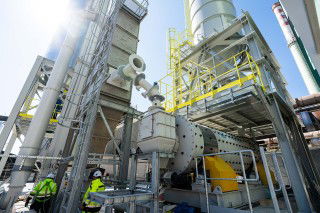This week JSW Cement announced that it was signing a new loan agreement that would be sustainability-linked to raise US$50m in debt capital to help achieve its 50Mta production capacity goal. While this is not JSW Cement's first such loan, ICR looks at the growing trend for committing to sustainability loans in the cement sector, and what they really offer for the environment and shareholders.
Sustainability-linked bonds (SLBs) and sustainability-linked loans (SLL) have become increasingly popular in the cement sector. SLB agreements see coupon rates rising when targets are met, or the issuer may pay a penalty when the bond matures or if it fails to meet the sustainability of ESG targets. The International Capital Market Association defines SLBs as "any type of bond instrument for which the financial and/or structural characteristics can vary depending on whether the issuer achieves predefined sustainability or Environmental, Social Governance (ESG) objectives."
SLLs are likely to see interest rates rising when the borrower fails to achieve the agreed sustainability targets and vice-versa. JSW Cement is among those that see great value in sustainability-linked loans (SLL). The first it agreed to was in October 2022 for INR4000m (US$48.6m) with MUFC Bank. The SLL is designed to reiterate the company's purpose of pursuing sustainable business growth via its use of industrial waste, including slag from the group's JSW Steel segment.
Heidelberg Materials claims to have made the most ambitious SLL through its syndicated credit line. Last year, it created a credit line over five years with two one-year extension options that link sustainability-linked loan principles (SLLP) to sustainability criteria, which are measured via key defined performance indicators (KPIs). René Aldach, Heidelberg Materials CFO, said, "We want to increase the proportion of sustainable financial instruments to over 70 per cent by 2025."
Companies applying for SLLs and SLLPs have to be clear in what goals they set for reaching the terms of their sustainability loan. Taiheyo Cement Corp, for example, has set sustainability performance targets (SPTs) for 2030 and 2050. By 2030, the company is aiming to lower its CO2 intensity in the supply chain by 20 per cent from its 2000-year level and by 2050 it will target a 40 per cent reduction in CO2 emissions compared to 2000. Meanwhile, Holcim's KPIs are linked to the industry's lowest emission intensity at 475kg CO2/t of cementitious material by 2030 and include KPIs for water usage intensity.
UltraTech Cement has similarly raised US$400m in SLBs. It aims to reduce its carbon emissions by 22.2 per cent for every tonne of cementitious material it produces by 31 March 2030 from the levels of March 2017. The bonds will refinance existing debt and fund ongoing capital expenditure and general corporate purposes.
Growing demand for SLL loans
Finance experts Cadwalader explain that the main demand for SLLs comes from stakeholders and has been driven by sustainable finance generally. These are the fastest-growing segment of the sustainable loan market. They offer increased ESG-related regulation and the potential for increased media scrutiny of sustainability performance. Any SPT is set at a level above the regulatory standard so that it is considered ambitious for the purpose of the SLLP. An incentive for the borrowers in the cement sector is to sell green cement at a premium when the KPIs of the SLL agreement are achieved.
A breach of SLL provisions usually only results in an upwards adjustment to the margin. "This is not often enough to change the borrowers' sustainability behaviour but it adds more ‘teeth' to a borrower's sustainability plans and requires higher transparency when a borrower fails to achieve a target," claims Cadwalader. Financial consultants Osborne Clarke state that one element of the SLL market that is underdeveloped is the obligation to re-evaluate the SPTs during the life of the financing. It is crucial to certify that the SPTs remain material, ambitious and meaningful.
Alternative pathways
The Science Based Targets Initiative (SBTi) guidance is considered the most suitable targeting for cement producers being based on a Sectorial Decarbonisation Approach (SDA) reflecting International Energy Agency modelling and because of its alignment to 1.5˚C global warming from the Paris Agreement. The Climate Bond Initiative (CBI) prefers to 'front load' company action to minimise the risk of companies in the sector leaving it until the last minute to try and decarbonise to meet their 2050 target. A further pathway is the Transition Pathway initiative (TPI) based on an SDA approach, but TPI do not include waste fuel emissions so are more focussed on decarbonisation KPIs.
Summary
The popularity of sustainability-linked loans and bonds for the cement sector is in their public credibility as well as being a financial tool with clearly-defined sustainability targets. Unlocking finance to meet climate change mitigating measures has been a powerful way for cement producers to enact change at plant, national and multinational level. By aligning corporate sustainability ambitions to increasing shareholder and stakeholder demands for cement and concrete production to reach net zero has been a force for change in the cement sector.
